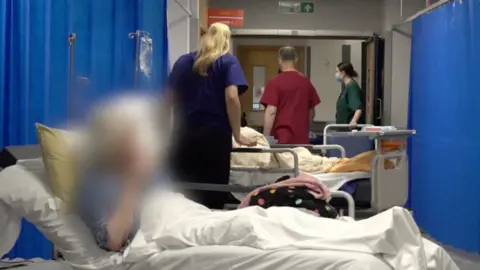Longest hospital waiting lists still rising
 BBC
BBCThe longest hospital waiting lists are continuing to rise in Wales.
There were 24,361 patient pathways at the end of November, an increase for a second month in a row after the Welsh government sets health boards a target to cut that figure to 8,000 by March.
The overall waiting list rose to 802,268 - setting a record for a 10th month in a row.
Meanwhile, the numbers waiting in A&E for 12 hours or more hit more than 10,800 - the second highest on record.
The health secretary said the NHS was facing "challenging circumstances" and the figures did not yet reflect the investment it was making to reduce the longest waits.
Nearly half of the two-year waits are for eye treatment or orthopaedics.
General surgery, dermatology - mostly patients in north Wales - and ear, nose and throat operations are the specialisms with the next longest waits.
Before the Covid pandemic, Wales had less than a couple of hundred long waits, but the backlog peaked at 68,000 in the spring of 2022.
Although this figure came down, in England these two-year waits have been virtually eradicated.
With numbers stubbornly remaining over 20,000 over the last year in Wales, the new health secretary announced funding for weekend working and private hospitals to slash the backlog.
Health Secretary Jeremy Miles said the figures did not yet reflect the investment.
"Health boards have assured me patients are getting faster treatment as a result and I look forward to seeing the impact of this in the coming months," he said.
The number waiting more than a year for treatment also rose, to 173,768, the highest level for more than two years.
When we look at only consultant-led specialisms, so we can compare with England, 24% are waiting more than a year in Wales, compared with 3% across the border.
But the scale of the challenge can be seen in more detailed figures seen by BBC Wales, which show 1,566 waits of more than three years in November.
Virtually all of these very long waits (91%) are in the troubled Betsi Cadwaladr health board, mostly in specialisms such as dermatology, orthodontics, general and oral surgery.
Unofficial figures show there were also 10 patients here waiting more than four years, including one patient waiting five and a half years.
Professor Jon Barry, director in Wales for the Royal College of Surgeons, said: "Momentum needs to continue so that the planned surgical hubs for Llandudno, Conwy County, and Llantrisant, Rhondda Cynon Taf, happen without delay."
The Conservatives called the figures "truly abysmal".
"People are dying unnecessarily the length and breadth of Wales, families are losing loved ones prematurely and NHS staff morale is plummeting," said health spokesman James Evans.
Plaid Cymru health spokesman Mabon ap Gwynfor said: "The Labour government have experimented with a series of plans to tackle this scandal all of which have failed."
The latest official waiting list figures also show:
- An improvement in performance against the target for patients starting their cancer treatment within 62 days of it being suspected. However, the number of patients waiting more than 62 days rose by 17% to 5,369.
- The number waiting more than a year for a first outpatient appointment continued to rise - to 82,335.
- Handover delays - the time spent by ambulances outside A&E units waiting to off-load patients - got worse and there were nearly 6,200 ambulances delayed outside emergency units for an hour or more.
- 47.6% of immediately life-threatening "red" ambulance calls arrived within the eight-minute target time, the same as the previous month. But the average number of red calls averaged 217 a day - the highest on record.
- There were 1,435 patients in hospital beds, medically-fit to be discharged, but with care support issues causing delays. This is similar to last month's figure.
- Because some patients are on more than one waiting list, it's estimated that 619,076 actual patients are waiting. This has reduced by 1,235 (0.2%) on the previous month.
Miles told BBC Wales he was doing everything he could to address the top priority "to make sure that people are being seen faster and being treated faster".
He said the extra funding would bring waiting times down, but acknowledged that new ways of working are also needed.
Director of the Welsh NHS Confederation Darren Hughes said: "Demand on NHS services remains historically high and, in some areas, we continue to see the highest levels of demand on record month after month.
"To put this into perspective, more people are ill and needing more complex care and treatment from our health and care services."
.
A&E performance worsened against the four-hour target, with only 64.8% seen under that time. Wrexham Maelor posted its second worst month on record.
When major A&E units are looked at, emergency units in Wales have performed comparatively worse to those in England for the last 10 months.
But Morriston Hospital in Swansea, featured in BBC Wales coverage on Thursday, has been performing better than other major A&E units on average since the summer of 2023.
It saw 58.7% of patients within the four-hour target in December.
Flu cases pass the winter peak
Meanwhile, flu cases among hospital in-patients have passed their peak although are still at "medium intensity" levels in the community.
Covid and RSV cases in hospital remain stable, according to latest Public Health Wales figures.
Screening of patients attending hospitals in Wales found the lowest positive tests for flu for two months.
Ambulance crews are also now dealing with fewer patients with respiratory complaints than earlier this month.
